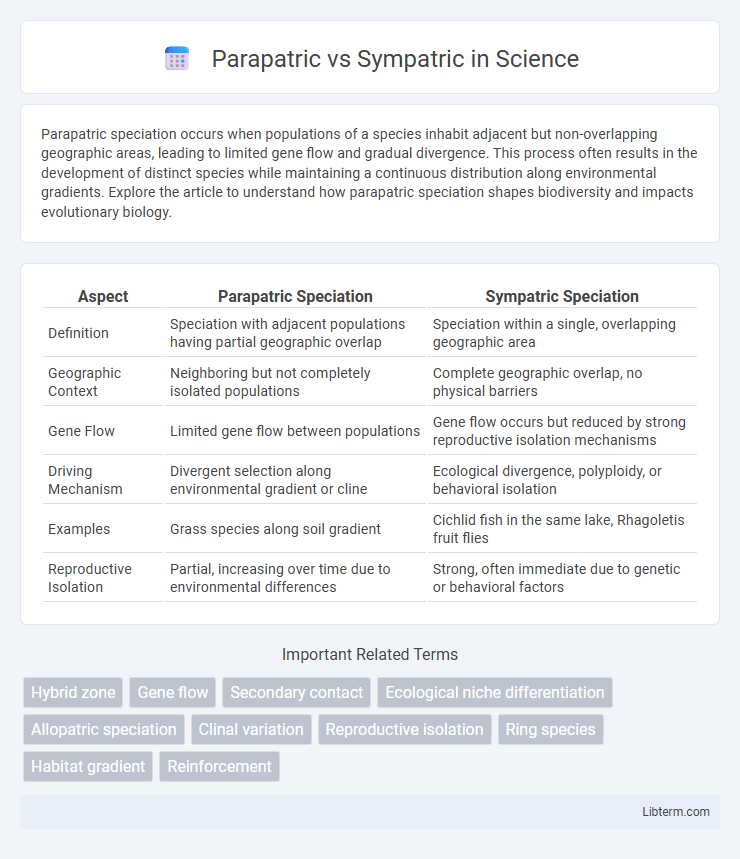Parapatric speciation occurs when populations of a species inhabit adjacent but non-overlapping geographic areas, leading to limited gene flow and gradual divergence. This process often results in the development of distinct species while maintaining a continuous distribution along environmental gradients. Explore the article to understand how parapatric speciation shapes biodiversity and impacts evolutionary biology.
Table of Comparison
| Aspect | Parapatric Speciation | Sympatric Speciation |
|---|---|---|
| Definition | Speciation with adjacent populations having partial geographic overlap | Speciation within a single, overlapping geographic area |
| Geographic Context | Neighboring but not completely isolated populations | Complete geographic overlap, no physical barriers |
| Gene Flow | Limited gene flow between populations | Gene flow occurs but reduced by strong reproductive isolation mechanisms |
| Driving Mechanism | Divergent selection along environmental gradient or cline | Ecological divergence, polyploidy, or behavioral isolation |
| Examples | Grass species along soil gradient | Cichlid fish in the same lake, Rhagoletis fruit flies |
| Reproductive Isolation | Partial, increasing over time due to environmental differences | Strong, often immediate due to genetic or behavioral factors |
Introduction to Parapatric and Sympatric Speciation
Parapatric speciation occurs when populations are adjacent but experience limited gene flow, leading to divergence through environmental gradients or partial isolation. Sympatric speciation arises within a single geographic area, driven by factors like disruptive selection or polyploidy that reduce gene flow despite overlapping ranges. Both processes contribute to biodiversity by promoting reproductive isolation without complete physical separation.
Defining Parapatric Speciation
Parapatric speciation occurs when populations of a species are partially isolated and experience limited gene flow due to adjacent but distinct habitats, leading to divergent evolution without complete geographic separation. Unlike sympatric speciation, which arises within the same geographic area, parapatric speciation involves a gradient of environmental conditions that creates selective pressures driving genetic differentiation. This form of speciation highlights how spatial variation and restricted mating opportunities contribute to reproductive isolation and eventual emergence of new species.
Understanding Sympatric Speciation
Sympatric speciation occurs when new species evolve from a single ancestral population without geographic isolation, often driven by genetic mutations, ecological niches, or behavioral changes. Unlike parapatric speciation, where populations are adjacent with limited gene flow along environmental gradients, sympatric speciation involves reproductive isolation within overlapping habitats. Understanding sympatric speciation sheds light on how speciation can proceed through mechanisms like polyploidy in plants or disruptive selection in animal populations, emphasizing the role of genetic and ecological divergence in the same geographic area.
Key Differences Between Parapatric and Sympatric Models
Parapatric speciation occurs when populations are adjacent but experience limited gene flow, often leading to divergence along environmental gradients, whereas sympatric speciation happens within overlapping geographic areas without physical barriers. Parapatric models emphasize spatially adjacent populations with partial isolation, while sympatric models rely on reproductive isolation mechanisms such as niche differentiation or sexual selection within the same area. The key difference lies in geographic context: parapatric speciation involves neighboring populations with some gene flow, and sympatric speciation involves complete geographic overlap with speciation driven by non-spatial factors.
Genetic Mechanisms Behind Parapatric Speciation
Parapatric speciation occurs when populations are adjacent but experience limited gene flow, leading to divergence through strong selective gradients and partial reproductive isolation. Genetic mechanisms behind parapatric speciation often involve clinal variation and local adaptation, where allele frequencies change spatially due to environmental heterogeneity. Hybrid zones emerge as key areas of genetic mixing and reinforcement, enabling the accumulation of reproductive barriers despite ongoing gene flow.
Ecological Factors Influencing Sympatric Speciation
Sympatric speciation is driven by ecological factors such as resource partitioning, habitat differentiation, and behavioral isolation within the same geographic area, enabling reproductive isolation without physical barriers. In contrast to parapatric speciation, where adjacent populations evolve due to limited gene flow across a gradient or contact zone, sympatric speciation relies heavily on niche specialization and disruptive selection. Examples include cichlid fish in African lakes and phytophagous insects exploiting different host plants, demonstrating ecological pressures that facilitate divergence despite geographic overlap.
Real-World Examples of Parapatric Speciation
Parapatric speciation occurs when populations of a species occupy adjacent but environmentally distinct habitats, leading to partial reproductive isolation without complete geographic separation. A notable example includes the grass species Anthoxanthum odoratum, which shows divergence along a heavy metal contamination gradient near mine sites in England. Another case is the Ensatina salamanders of California, where continuous populations exhibit localized adaptations and limited gene flow, resulting in a ring species complex with distinct subspecies around the Central Valley.
Notable Cases of Sympatric Speciation
Notable cases of sympatric speciation include cichlid fish in African Great Lakes, where ecological niches and mate preferences drive reproductive isolation without geographic barriers. Another example is the apple maggot fly (Rhagoletis pomonella), which shifted from hawthorn to apple trees, leading to genetic divergence in overlapping habitats. These instances highlight sympatric speciation's role in biodiversity through genetic differentiation and niche specialization within shared environments.
Evolutionary Implications and Conservation Significance
Parapatric speciation occurs when populations are adjacent but experience limited gene flow, leading to divergence driven by environmental gradients and selection pressures, while sympatric speciation arises within overlapping populations primarily through ecological niches or behavioral barriers. Evolutionary implications of parapatric speciation include the promotion of genetic differentiation across spatially variable environments, whereas sympatric speciation highlights the role of ecological specialization in diversifying species without geographic isolation. Conservation significance lies in recognizing habitat heterogeneity for parapatric populations to maintain adaptive potential, and preserving ecological interactions in sympatric zones to prevent loss of niche-specific species and genetic diversity.
Conclusion: Parapatric vs Sympatric Speciation
Parapatric speciation occurs when populations are partially isolated with limited gene flow along a contiguous range, promoting divergence due to environmental gradients or selective pressures. Sympatric speciation happens within the same geographic area, driven by factors like ecological niche differentiation or genetic mutations leading to reproductive isolation. Understanding the distinction highlights the role of spatial separation and ecological factors in shaping species divergence mechanisms.
Parapatric Infographic

 libterm.com
libterm.com